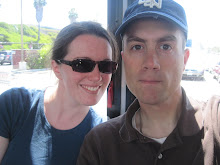John Henry Newman's An Essay on the Development of Christian Doctrine is no easy read. So I was glad to be able to actually follow him last night in his discussion of the first note of doctrinal development (vs. a corruption) in the context of the 4th Century.
These "notes" form a canon by which Newman devises to measure the true church, and his first is that "one security against error and perversion... is the maintenance of the original type, which the idea presented to the world at its origin, amid and through all its apparent changes and vicissitudes from first to last. (207, emphasis added)"
In the particular context of the 4th Century, he notes the pervasiveness of various sects and their outward Christian appearances. His question, applicable today as ever, is "How was the man to guide his course who wished to join himself to the doctrine and fellowship of the Apostles [in those times]? (248)"
He then begins a historical tour de force to show sectarian pervasiveness: the Meletians had 1/3rd the total bishops in the whole Egyptian Patriarchate, later Donatists had 400 bishops compared to the 468 catholic ones, the Arians were in possession of Constantinople's 100 churches, and so on. These sects were variously learned, eloquent and talented (some possessed noteworthy skills of Biblical interpretation). They had "normal" looking church buildings, they had bishops, priests and deacons, celebrants and altars, and of course school.
Again Newman asks, "How was an individual inquirer to find, or a private Christian to keep the Truth, amid so many rival teachers? (251)" It was no easy decision, and he reminds us of some early Saints who flirted with other teachings or were converts to the catholic church from the various sects (most notably St. Augustine, who spent 9 years in Manicheanism). The answer: "The Church is everywhere, but it is one; sects are everywhere, but they are many, independent and discordant. Catholicity is the attribute of the Church, independency of sectaries. (Ibid.)"
And again, "The Church is a kingdom; a heresy is a family rather than a kingdom; and as a family continually divides and sends out branches, founding new houses, and propagating itself in colonies, each of them as independent as its original head, so was it with heresy. (emphasis added)" He supports the proposition that division is a distinguishing feature of sects by listing the (obscure) descendants of early heresies (see 252). For example, Montanists evolved into Tascodrugites, Pepuzians, Artotyrites, and Quartodecimans -- I really watch out for those Pepuzians! This continuing fracture of heresy came from its nature: "its own master, free to change, self-sufficient; and, having thrown off the yoke of the Church, it was little likely to submit to any usurped and spurious authority. (253)"
Their sole uniting aspect was their hatred of the Church. Here are some (now) entertaining libelous quotes he finds from the works of heretics about the Church: "the carnal", "the apostates", "the worldly", the man-worshippers", "the flesh-lovers", "the slimy", "servants of Antichrist", "synagogue of Satan" and "the devil's harlot." St. Peter's chair was called "the seat of pestilence."
I tell you, some of those sound as if they were penned in the early 16th century.
Thursday, January 3, 2008
Subscribe to:
Post Comments (Atom)


2 comments:
Or the 21st. I need to add Newman to my reading list!
Tim,
Be forewarned that he really isn't easy reading. It's not so much his writing style (though his style is somewhat more nuanced than Joel Osteen). It's his references to obscure apologists with whom he's interacted and to whom he responds in the work. Not knowing the context of those debates and not knowing who those folks are (as I certainly don't), large passages give me glazed-over eyes. But hey, when I'm tuned in, he's fabulous!
Peace in Christ,
Thos.
Post a Comment